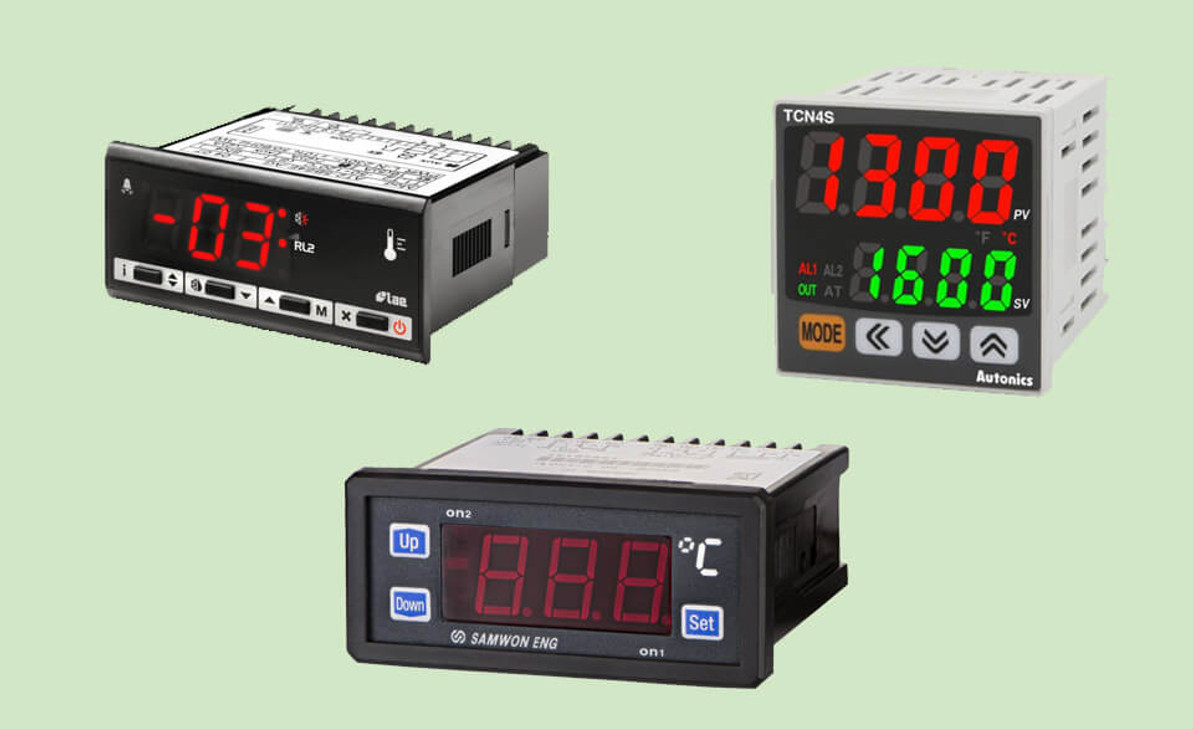Temperature Controller And Process Controller
In this article, we will discuss Temperature Controller and Process Controller, and provide you with their similarities and differences. we will also explain in details how a controller works, what are its types, its inputs and outputs and at the end we will tell you where these equipment help us in the industries.
Temperature Controllers
Temperature controller is an equipment to control the temperature. This device accurately controls the temperature without the need for extensive operator intervention. It's also known as a temp controller.
The controller inside a temperature control system accepts a temperature sensor such as a thermocouple or RTD as an input.
It compares the measured temperature with its set point temperature and then produces an output for a control element such as a heater or fan.
The controller is only one part of the temperature control system and the whole system should be analyzed to select the appropriate controller.
Browse our Inventory online in Temperature Controller category.
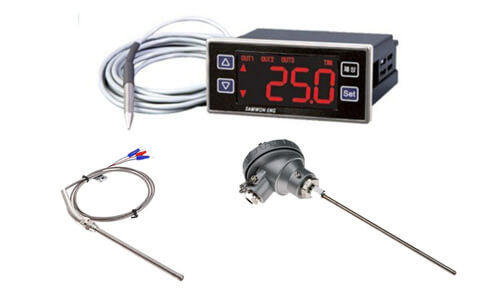
Process Controllers
The process is defined as a technique of changing or refining raw materials to produce the final product.
The raw material may be solid, liquid, gas, or slurry. Once a product is made, the process variables need to be controlled to a defined and predetermined pattern to achieve a quality product. This is where process controllers come in.
In other words, process controllers measure and control the process variables such as temperature, pressure, volume, flow, displacements, chemical, and physical properties of materials for producing the final product.
For example, consider a process in which two materials must be mixed in a defined proportion and at certain temperatures.
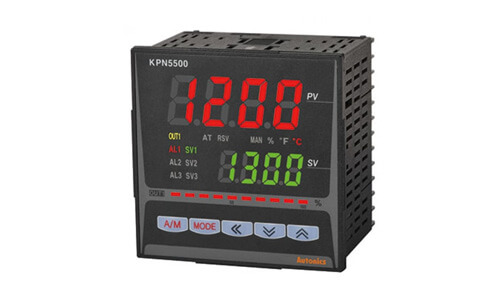
The final product is a powder made of these two materials at a constant pressure. Weight or volume, temperature, and pressure are the measurements involved in the process.
We must control the proportions, temperature, and pressure. Proportion, temperature, and pressure controller are three controllers needed in this process that may be combined into one process controller.
In conclusion, we can say that a temp controller is also a process controller. Furthermore, it can be said that the process controller is part of a process control system.
Temp Controller versus Process Controller
Process and temperature controllers are similar in many ways and there are many differences in terms of structure, performance, and applications.
Similarities:
- Temperature and process controllers have the same basic principle. There is a reference control parameter for a controller that is continuously compared to the measured parameter by a sensor and generates a fault signal.
A system input must be generated for the process by the controller. The controller task is to maintain the error signal zero or close to the approved accuracy of the controller.
- Both temperature and pressure controllers have the same control mechanism. On-off, proportional, PID or fuzzy logic control are control types of these controllers.
In both cases, the involvement of the operator needs to be minimized. In addition, electronic control circuits, algorithms, the set point adjustment techniques, as well as the output signal to the system actuator are similar.
Differences:
- The function of the temp controller is to control only the temperature parameter in a process. But the process controller controls multiple parameters such as flow, volume, pressure, weight, viscosity, proportions, etc.
- Temperature controller sensors such as thermocouples, RTD, etc. are just allowed for measuring temperature. Strain gauges, LVDT, Orifice, chemical sensors, and many more sensors are used in process controllers.
- Process controllers are generated with some relevant logic control systems. Temp controllers are usually manufactured with ordinary logic control mechanism.
There is programmable logic control (PLC), distributed control systems, and SCADA systems in process controllers. The process controller is well suited for batch or continuous control systems and also they can execute statistical process control through chart control.
How it Works
Controllers are made from basic to the most complex form and all work almost in the same way. The task of a controller is to control or keep, some variable or parameter at a set value.
The controller needs two variables; the actual input signal and desired set point value. The input signal or the process value is sampled many times per second, based on the controller and then this input is compared with the set point value.
If the input signal does not match the set point, the controller produces an output signal change depending on the variation between the set point and the actual value and whether the actual value is close to the set point. Afterward, for correcting the actual value to match the set point, this output signal starts some type of response.
Usually, the control algorithm changes and corrects the output power value, which is then applied to the output.
One of the simplest types of control to execute is ON / OFF control. It works based on the setting up of the hysteresis band.
For example, a temp controller may be set up to control the room temperature. If the set point is 68° and the actual temperature drops to 67°, an error signal indicates a difference of –1°.
The controller then sends a signal to increase the applied heat to bring the temperature to the set point of 68°. When the temperature reaches 68°, the heater turns off.
If the temperature is between 68° and 67°, the controller does nothing and the heater stays off. However, when the temperature reaches 67°, the heater turns on again.
PID control operates differently. It determines the exact output needed to keep the desired temperature. Output power can vary from 0 to 100%.
If an analog output type is used, the output drive would be corresponding to the amount of output power. However, if the output is a binary output such as a relay, SSR driver, or TRIAC, the output must be proportional to obtain an analog display.
A time-proportional system uses cycle time to fit the output value. If 8 seconds is determined for cycle time, a system that requires 50% power will have 4 seconds output and 4 seconds off.
Time values do not change until the power value changes. If all things are equal, shorter cycle times are better because the controller can react more quickly and change the output state for given changes in the process.
Different Types of Temp Controllers
In general, we have three basic types of controllers: on / off, proportional, and PID temperature controllers. According to the system to be controlled the operator can use one model or another to control the process.
On/Off Temp Controller
On / Off controllers are the simplest type of temperature control device. The output of this type of device only includes on / off and has no other output (for example, middle mode). This system changes its output only when the temperature passes the set point (above or below the set point).
Because the temperature must go from below to above the set point to change the output state of the controller, the temperature process becomes a continuous cycle that fluctuates above and below the set point.
In the cases that this cycle occurs too rapidly, an on / off differential or hysteresis is added to the controller operations to prevent damage to the contractors and other devices.
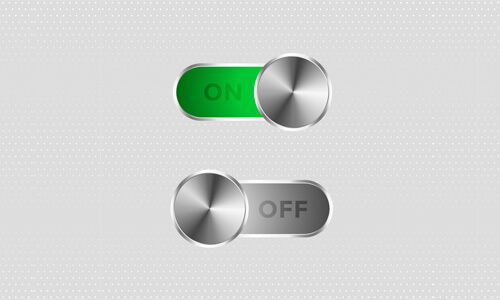
Using this method, the temperature must be higher or lower than the set point to change the output. This prevents the output of the system from chattering or making rapid and continuous switches if the cycling above and below occurs too quickly.
On / Off model controllers are generally used in cases where precise control is not required, in systems that can not withstand continuous turned on and off of energy, or the system mass is so high that the temperature changes very slowly or it is used for temperature alarms (in cases where the controller output is connected to the alarm).
A special model of the On / Off controller that is used for alarm is the limit controller. This controller uses a latching relay that must be reset manually and is used in cases where the whole system must be shut down if the temperature exceeds the specified limit.
Proportional Control
Proportional controllers are designed to eliminate the on/off cycle that occurs in On / Off controllers. A proportional controller reduces the average amount of power supplied to the heating system (e.g. the element) if the temperature reaches the set point.
Its effect is to reduce the speed of the heating system causing the system temperature not to exceed the set point but to reach it and keep a stable temperature.
This proportional function can also be achieved by turning the output on and off at short times and specified intervals.
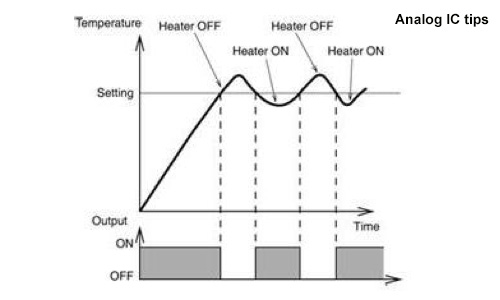
This "time proportioning" changes the relative amount of on and off time to control the system temperature.
Temperature proportioning occurs around the set point temperature, which is called the Proportional Band. Outside this band, the controller operates as a simple On / Off unit with an output that is either on (below the band) or off (above the band).
But when the system temperature is within the specified band, the output starts to turn on and off in proportion to the difference between the input temperature and the set point.
At the set point temperature (actually in the middle of the band), the on-off ratio is 1: 1, which means that the on-time interval will be equal to the off-time interval.
If the temperature is further than the set point, this time ratio between on and off varies according to the temperature difference. If the temperature is lower than the set point, the output is on longer and if it is higher than the set point, it is off longer.
PID Control
The third type of controller offers proportional with integral and derivative control, which is called PID for short.
This controller puts proportional control with two additional adjustments, which allows the unit to automatically compensate for changes that occur in the system.
These two adjustments, integral and derivative, are expressed as time-based units. They are also identified by their reciprocal names, which are RESET and RATE, respectively.
All three proportional, integral, and derivative terms must be set or "tuned" for a specific system using trial and error.
This model is the most accurate and stable model among the three controller types and is very suitable for systems that have a relatively small mass.
These systems respond quickly to energy changes added to the process. This model is also proposed in systems where the load changes regularly and it is expected that the controller will be able to adapt to the constant changes that occur at the set point temperature, the amount of energy available, and the amount of mass to be controlled.
Auto tuning, Self-tuning
The function of "Auto tuning" or "self-tuning" in PID controllers is to simplify matters by selecting their own tuning parameters depending on some type of automatic controlled process’s behavior analysis.
These procedures are automatic and often include a mathematical model of the process’s input/output relationship that is obtained from process data completed by information prepared by an experienced operator.
"Self-tuning" is related to such procedures that are constantly implemented while the controller adjusts the process online.
"Auto tuning" means that on-demand procedures are implemented when the controller is offline or the controller is tuned automatically. Since both self-tuning and auto tuning controllers automatically adjust themselves, they often are used interchangeably.
Auto tuning
The constant values and combinations of PID that are used for temperature control depend on the properties of the controlled target object. There are different and common methods that are used to get the PID constants.
These methods are proposed and executed based on the temperature waveforms actually controlled. It is possible to get PID constants that are suitable for a variety of control objects using Auto-tuning methods. The most popular types of auto-tuning include the step response, marginal sensitivity, and limit cycle methods.
Step Response Method
The most frequent value used by the user is the set value in this method. The maximum temperature gradient (R) and dead time (L) are determined from a 100% step-type MV output and then the PID constant can be calculated from the values of R and L.
Limit Sensitivity Method or Marginal Sensitivity Method
Marginal Sensitivity is a method to get the PID constants from the proportional band and oscillation cycle. Temperature oscillation is produced by gradually reducing the width of the proportional band that starts from the start time (point A).
Limit Cycle Method
The hunting cycle and oscillations are calculated by repeating ON and OFF operations for the set value. Limit Cycle is a method to obtain the PID constants from the hunting cycle and oscillations.
Self-tuning
Self-tuning is executed when the controller itself determines the start point of tuning, and tuning can be done without disturbances in the controlled temperature. In other words, self-tuning calculates and sets the PID constant based on the characteristics of the controlled system to continuously make optimum control possible.
There are three modes that are used for self-tuning.
(1) Calculation of PID constants when set values are changed.
(2) Correction of PID constants when external disturbances occur in the temperature so that the temperature falls within a determined range.
(3) Correction of PID constants when there is hunting to eliminate hunting.
Auto tuning function Versus Self-tuning function
Auto-tuning indicated as AT is executed only when manually instructed, or specified. In the auto-tuning function, a limit cycle signal is generated to disturb the temperature in order to perform tuning.
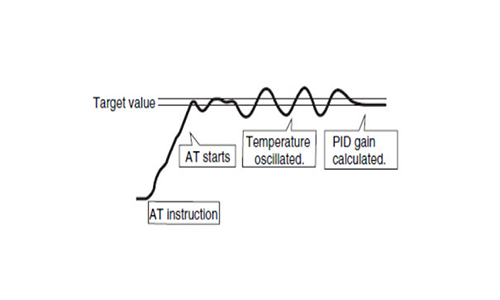
Self-tuning indicated as ST is automatically performed by the controller and in this function, a signal does not generate to disturb the temperature.
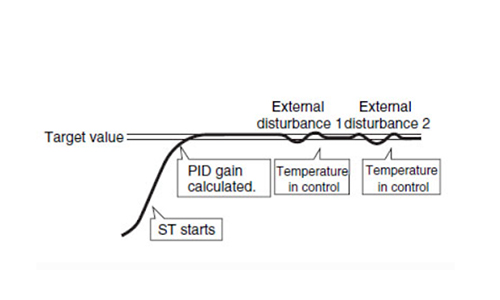
Input / Output
Input
There are different types of input for temp controllers. The type of input sensor and the required signal may differ based on the type of process being controlled.
Thermocouples and resistive thermal devices (RTDs) and linear inputs such as mV and mA are among common input sensors.
Typical standard thermocouple types are J, K, T, R, S, B, and L, among others. Also, the controllers can be set to receive RTD as the temperature input. A typical RTD can be a 100Ω platinum sensor.
Also, controllers can be set to receive input from other types of sensors including pressure, level, or flow sensors in the form of voltage or current signals in the millivolt, volt, or milliamp range.0 to 5VDC, 1 to 5VDC, 0 to 10VDC and 2 to 10VDC are typical input voltage signals.
Millivolt signals include 0 to 50mVDC and 10 to 50mVDC and milliamp signals such as 0 to 20mA or 4 to 20mA from sensors can also be accepted by controllers.
Output
Each controller not only has an input but also an output. Each output can be used to perform several tasks, such as controlling a process (like turning on a heating or cooling source), starting an alarm, or retransmitting the process value to a programmable logic controller (PLC) or recording.
Relay outputs, TRIAC, solid-state relay (SSR) drivers, and linear analog outputs are common outputs provided with temp controllers.
The relay has an output that usually features a single-pole double-throw(SPDT) relay with a DC voltage coil. The controller provides power and energy for the relay coil and causes the contacts to isolate.
In this situation, contacts can control the external voltage source to power the coil of a much larger heating contractor.
It should be noted that the relay contacts usually have a current rating of less than 2A. The contacts can control a 10-20A rate heating contactor used by heating bands or heating elements.
SSR driver is another type of output. These types of outputs are logic outputs and their function is to turn a solid-state relay on or off.
3 to 32VDC is needed for most solid-state relays to turn on. A typical SSR driver turn-on signal of 10V has the ability to drive three solid-state relays.
A TRIAC is a solid-state device that is used to control currents up to 1A and does not have a moving part. Its outputs may generate a small amount of bleed current, usually less than 50mA.
This bleed current has no effect on heating contactor circuits, but it may be problematic if the output is used to connect to another solid-state circuit, as the input of the PLC.
Some controllers provide analog outputs that generate a 0–10V signal or a 4–20mA signal. The calibration of these output signals is that the signal changes as a percentage of the output.
Other Parameters Related to Performance of Temp Controller
Set Point
A set point is the desired value determined by an operator that the controller's goal is to keep it stable.
Hysteresis
Hysteresis is a band of change in process variables around the set point needed to re-energize the control or alarm output.
Dead band
The dead band is a selected region around the set point where proportional control is restricted. It is generally between the heating and cooling proportional bands.
Alarm Value
The alarm value is used to indicate when a process has reached certain conditions. There are different variations in types of alarms.
For example, the high alarm may indicate that the temperature is hotter than the set point. Similarly, a low alarm indicates that the temperature has reduced below the set point.
Loop Alarm
A loop alarm is a feature to test for a broken output device, such as an open heating element. The controller checks the amount of output signal and compares it to the amount of change detected in the input signal.
For instance, if the output signal reach100% and the input sensor does not identify any change in temperature after a certain time period, the controller will recognize that the loop is broken.
Band alarm
A change on the deviation alarm is defined as the band alarm. This alarm is activated inside or outside a specified temperature band. Typically, the warning points are half higher and half below the controller set point.
Event
The event is the ON / OFF output signal that is programmable and can control supporting equipment or processes or perform as an input for other control loops.
Analog transmission (Retransmission)
in Analog transmission data is transmitted as a continuous signal. It is contrary to the on/off digital signal.
Baud Rate
Baud Rate is defined as the rate of information transfer in serial communications. It is measured in bits per second.
Precision
Precision is the proximity of a calibration, indication, setting, or control of a measurement instrument to the actual value of the measured quantity. It is usually expressed as a percentage of the full-scale
Accuracy
Accuracy is expressed as the closeness between the value presented by a measuring device and the corresponding true value. The accuracy of the Sensor is based on US NIST (NBS) standards.
Indication Accuracy
The permissible range of error in the indicated value for the input of a sensor.
Resolution
Resolution is the precision of a value being measured. When the resolution is increased it does not necessarily mean increased accuracy.
Sampling Rate
The sampling rate defines the rate at which input data is polled for information.
Calibration
Calibration is the process of comparing a measurement device (an unknown) with an equal or better standard.
Standard Sizes
Since temp controllers are normally installed in the instrument panel, the panel must be cut to the size of the temp controller.
In order to provide switching conditions between controllers, many controllers are produced in standard DIN sizes such as 1/4 DIN, 1/8 DIN, 1/16 DIN, and 1/32 DIN.
It simply shows that a device conforms to a general approved standard for the panel dimensions.
DIN size comparison
| Din Size | 1/4 | 1/8 | 1/16 | 1/32 |
| Size in mm | 92x92 | 92x45 | 45x45 | 49x25 |
| Size in inches | 3.62x3.623 | 3.62x1.77 | 1.77x1.77 | 1.93x0.98 |
It should be noted that the DIN standards do not specify how deep a controller is behind a panel. They only allow for front panel dimensions and panel cut-out dimensions.
Front Panel Enclosure Rating
Front panel enclosure rating is an important characteristic of the controller. These ratings can be an IP rating or a NEMA rating. IP (Ingress Protection) ratings can be used for all controllers and are typically IP65 or higher.
This rating can completely protect the front panel only from dust and against low-pressure jets of water from all directions with only limited ingress permitted.
A NEMA rating or National Electrical Manufacturers Association for controllers is similar to the IP rating. Most controllers offer NEMA 4 or 4X ratings. This means they are well suited for use in applications that need water wash down only (not oils or solvents). The X in NEMA 4 rating indicates that the front panel will not corrode.
Approvals
A temp controller should have some sort of agency approval to make sure that the controller provides a minimum set of safety standards.
The type of approval is based on the country where the controller is used. UL and cUL registration are the most common approval that applies to all controllers used in the U.S. and Canada. Usually, one certification is necessary for each country.
CE approval is required for controllers that are used in European Union countries.
FM is the third type of approval that applies just to limited devices and for controllers in the U.S. and Canada.
Alternatively, RoHS and WEEE compliance should be taken into account when selecting temp controllers.
The Restriction of Hazardous Substances directive known as RoHS is a European Union order. Accordingly, the use of six hazardous materials in the production of electronic and electrical instruments has been restricted.
Although they are often known as "lead-free" products, RoHS products have less than 0.1% of lead, mercury, cadmium, hexavalent chromium (Cr6+), and polybrominated biphenyls (PBB), polybrominated diphenyl ether (PBDE).
It protects the workers of the electronics industry and persons who are near areas where waste electronic items are stored. RoHS products have been tested in the best way to resist harsh environmental conditions and strict vibration and shock requirements.
WEEE or the Waste Electrical and Electronic Equipment Directive (WEEE) is a law that determines the target of collection, recycling, and recovery of electrical products, with the lowest amounts for recycling recovery.
Manufacturers and distributors who are in compliance with WEEE must allow users the possibility of returning household electronic equipment to them for free recycling.
Application
Temp controllers are used in a wide range of industries to manage production processes or operations. They can be used in plastic extrusion and injection molding machines, packaging machines, food processing, thermoforming machines, food storage, and blood banks.
We provide a brief overview of some common temperature control applications in the industry as the following:
- Heat Treat/Ovens are one of the common usages of Temperature controllers. They can be used in heat-treating applications within furnaces, ceramic kilns, boilers, and heat exchangers.
- Packaging: It is necessary for some processes or devices in the packaging industry such as machinery equipped with seal bars, glue applicators, hot melt functions, shrink wrap tunnels, or label applicators to operate at specified temperatures and process time lengths. Temp controllers are well suited to precisely set these operations to generate high-quality products.
- Plastics Portable chillers, hoppers, dryers, and molding and extruding equipment in the plastics industry need controlling of temperature. For example, in extruding equipment, temp controllers are employed to precisely monitor and control temperatures at various critical points in the manufacture of plastic.
- Healthcare Temperature control and its accuracy are important factors in the healthcare industry. laboratory and test equipment, autoclaves, incubators, refrigeration equipment, crystallization growing chambers, and test chambers are common equipment using temp controllers. In this equipment, specimens are kept and tested within designated temperature parameters.
- Food & Beverage Temperature controllers are commonly used in food processing applications including brewing, blending, sterilization, and cooking and baking ovens. Controllers monitor temperature and/or process time to provide optimum performance.
Other Controller Definition
Batch Controller
Batch controllers are used to keep the correct size of a discrete batch of process material, like the volume of a liquid. They are often used in conjunction with sensors such as load cells, or with volumetric flow meters.
Flow Controller
Flow controllers are used to monitor and keep flow-rate variables, generally in process applications.
Humidity Controller
The function of humidity controllers is to monitor and keep specified humidity levels in environmental test applications, food storage areas, and electronic equipment rooms. Humidity controllers often involve rate indication features and totalizer, data logger, and chart recorder capabilities.
Level Controller
Level controllers are used to monitor, regulate, and control liquid or solid levels in a process.
Pump Controller
In order to maintain the desired levels, pump controllers monitor flow and/or level variables, and control a pump. Pump control can involve easily turning a pump on and off, or more advanced controls for pump speed, output pressure, etc.
The following articles on our website may be of interest to you:
Panel Meter (Types, Input, Output, Sizes and Applications)
Conductivity Meter (Working Principle, Types, Use)
Recent Posts
-
Booster Pump Troubleshooting and Maintenance: How to Fix and Prevent Common Issues
1. Introduction Imagine turning on your faucet only to be greeted with a weak trickle of water when …22nd Apr 2025 -
Energy-Efficient Booster Pumps: Selection and Tips for Maximizing Performance
1. Introduction Imagine never having to deal with fluctuating water pressure, noisy pumps, or skyroc …19th Apr 2025 -
Booster Pumps for Sustainable Water Systems: Irrigation and Rainwater Harvesting Solutions
1. Introduction Water scarcity is no longer a distant threat—it’s a reality affecting millions …16th Apr 2025

